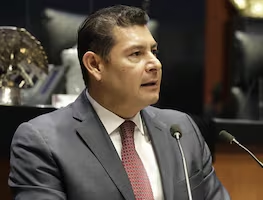Más Información

Artistas plasman siluetas migrantes en muro fronterizo de Tijuana; protestan contra políticas migratorias de Trump

Gobierno de México refuerza su compromiso con programas para el Bienestar; entrega tarjetas en Puebla

Esteban Moctezuma aboga por migrantes; alcaldes demócratas y republicanos muestran solidaridad migratoria

¿Perdiste tu cartilla de Servicio Militar? Te decimos cómo reponerla; consulta los requisitos y su trámite en línea o presencial
The concentration of arsenic and fluoride in the Lerma-Chapala aquifer doubled in the last 14 years, a study conducted by the Center for Geosciences (CGEO) of the National Autonomous University of Mexico (UNAM) revealed.
According to the study, groundwater in six states could follow the same trend: Querétaro, San Luis Potosí, Aguascalientes, Zacatecas, Durango and Sinaloa.
Marcos Adrián Guerrero Ortega, head of the Mobile Laboratory to Track Contaminants in the Subsurface of CGEO, has monitored the basin since 1998.
In an interview with EL UNIVERSAL, Guerrero said that the concentrations of fluoride and arsenic found until 2001 in over 250 wells in the basin covering an area of 500 square kilometers (193 square miles) had concentrations up to 10 times above the acceptable limits for human consumption (1.5 milligrams per liter, as established in the Norm No. 127 of the Ministry of Health).
"Now the area has increased to 800 square kilometers (308 square miles) and concentrations have doubled in some places. As for arsenic, which is carcinogenic, it exceeds the limit by 20 or 30 times," said the PhD in Science from the University of Waterloo and UNAM professor.
This means in the Lerma-Chapala Basin, which spans from the State of Mexico to Jalisco covering over 7,000 square kilometers (2,702 square miles), there is an area of the size of the metropolitan area of Guadalajara “drowned” in substances harmful to humans: an expansive miasma that not only destroys the teeth and skeleton of people, but also causes irreversible neuronal damage, alters DNA, complicates births and is a carcinogenic factor.
"Arsenic is causing cancer in the population. Moreover in the last 15 years fluoride went from causing dental fluorosis and skeletal damage to damaging neurotransmitters, which reduces IQ between 40% and 50%. This means children stop learning irreversibly, " Ortega, who has also worked for the Senate as adviser on underground water, explained.
The area in which the contaminated wells are located belongs to the aquifers of La Laja River and Laguna Seca, better known as the "Basin of Independence".
"The water with arsenic, fluoride, aluminum and other elements come from deep flows that are reaching the upper aquifer from fractured rocks of volcanic origin, i.e. it is thermal water that ascends by density," Dr. Ortega said.
He added that the irrational exploitation of the basin has created deep depressions: in the 50s it was at ground level, whereas today it has reached a depth of 150 and 250 meters (492 to 820 feet) and they are still drilling wells.
According to the researcher, in the 60s, 70s and 80s there was a limit of 700,000 wells, but by the end of the 90s there were 2,500 wells, compared with over 3,000 at present.
The Superior Audit of the Federation (ASF) has found 16 aquifers in seven states with brackish and saline water above tolerable limits for human consumption: 2,000 milligrams per liter. This type of pollution causes coronary diseases and other ailments related to excessive sodium, such as hypertension and osteoporosis, apart from creating digestive and circulatory problems.
The acquifers are Oriente Aguanaval-Nazas and Villa de Juárez (Durango), Cedros (Zacatecas), Cedral-Metehuala and Matehuala Huizache (San Luis Potosí), Vicente Guerrero, Santo Domingo, La Paz, Los Planes and San Rafael (Baja California), Costa de Hermosillo, Caborca, Valle de Guaymas and Sonoyta-Puerto Peñasco (Sonora), Cuautitlán-Pachuca (State of Mexico and Hidalgo).
As for surface water, such as rivers, lakes, lagoons and channels, the ASF found that of the 13 administrative zones in which the National Water Commission (Conagua) divides the country, all were polluted with oil, plastics and pesticides, and in eight of them (61%), water contained feces, parasites and bacteria."
Noticias según tus intereses

Confiesan pago por preguntas en la Mañanera | El Universal

Lo que esconde Clara Brugada en la Ciudad de México | El Universal

Luisa Alcalde responde a solicitud de Nahle sobre afiliación de Yunes; Comisión de Honestidad del partido decidirá | El Universal

EU publica oficialmente aranceles de 25% a acero y aluminio; Casa Blanca acusa a México de recibir inversiones chinas en aluminio | El Universal

Chivas cambiará de televisora; saldrá de Fox Sports | El Universal







